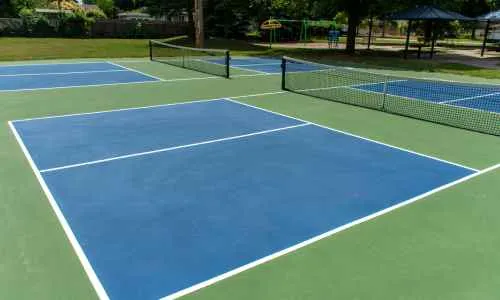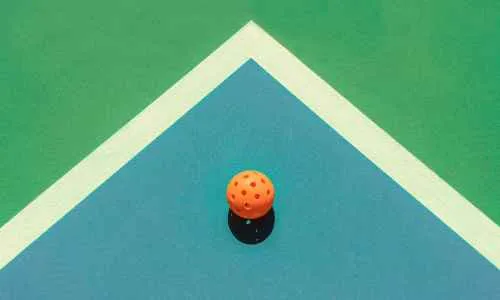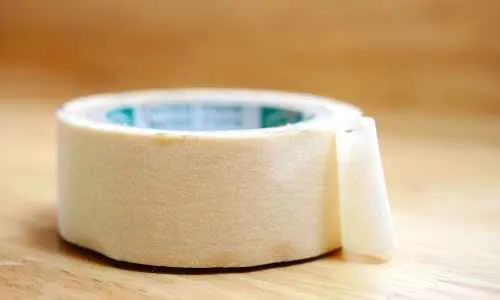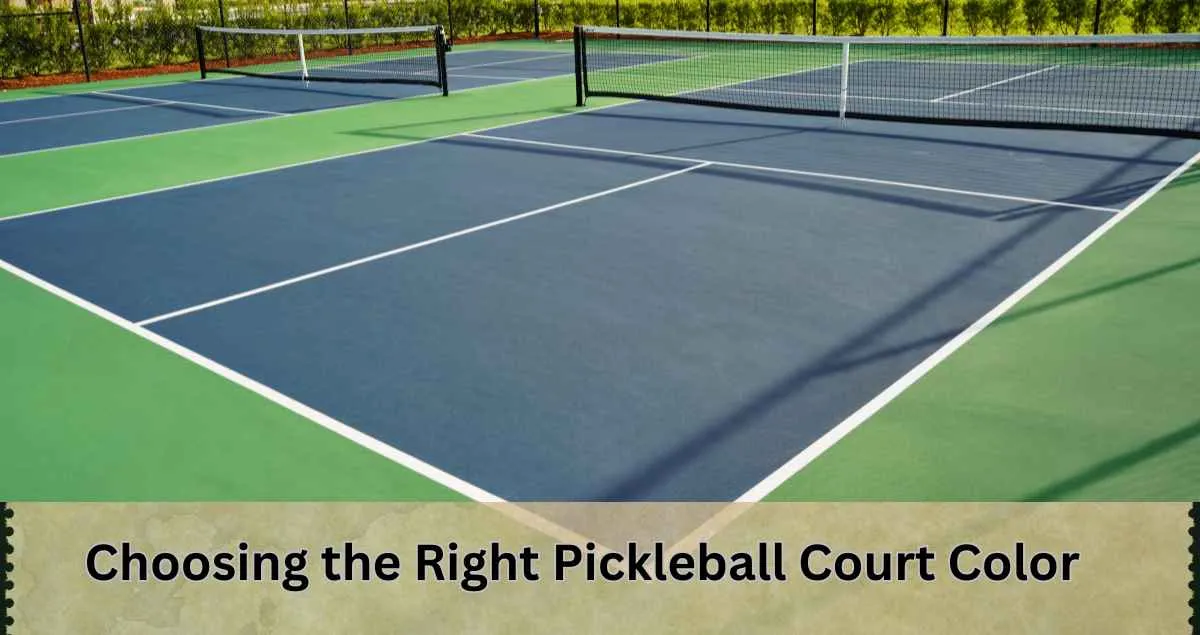Enhance Your Court with Vibrant Pickleball Court Colors! Discover a Wide Range of Color Options for Your Pickleball Court Surface. Elevate Your Game Today.
Pickleball is an enjoyable and thrilling sport that can be played in various settings, both indoors and outdoors, typically on a court resembling a scaled-down tennis court. An appropriate color scheme is among the paramount considerations in designing a pickleball court.
The color of the court can significantly impact the visibility of the ball, the players’ comfort, and the overall aesthetic appeal of the environment. The article delves into the significance of color in court design, outlines the key factors to weigh when deciding on pickleball court colors, and presents some of the top color scheme options.
Table of Contents
Importance of Color in Court Design
People often underestimate the importance of color in pickleball court design, but it significantly enhances the overall playing experience, safety, and aesthetics. Here are several reasons why color is crucial in pickleball court design:
Visibility and Safety: The selection of colors for court lines and playing surfaces impacts visibility during gameplay. High-contrast color combinations, such as dark lines on a light background or vice versa, make it easier for players to distinguish boundaries and disputes related to in or out calls. Good visibility also ensures players can see the ball clearly, enhancing their ability to react quickly.
Branding and Identity: Some pickleball facilities may want to incorporate specific colors into their court design to reflect their branding or identity. Customizing court colors to match a club’s or organization’s brand can help build community and pride among players and supporters.

Sunlight and Heat Management: In outdoor pickleball courts, the color of the playing surface can affect temperature. Lighter-colored courts tend to absorb less heat from the sun, making the court cooler and more comfortable for players. This consideration is critical in regions with hot climates.
Maintenance and Durability: Color choices can impact the care and longevity of the court. Some colors may fade or wear more quickly, so durable, fade-resistant materials are essential to keep the court looking its best over time.
How Much Does It Cost To Paint A Pickleball Court? In (2023)
Key Considerations for Choosing Pickleball Court Color
Choosing the ideal color for the pickleball court is more than just an issue of taste; it may also impact how enjoyable the game will be. Here, we’ll review the key elements to consider while deciding on the ideal color scheme for your court.
Heat Absorption
Darker colors absorb more heat and raise the court’s temperature, while lighter colors absorb less solar radiation and keep the court cooler. On a hot day, it may impact the players’ comfort.
Visibility
Visibility on the court is crucial for player safety and enjoyment. Opt for colors that contrast the playing surface and court lines. It ensures that players can easily track the ball and make accurate shots.
Contrast
Contrasting colors for court lines and the playing surface are vital. For example, a classic green and white combination offers excellent visibility and contrast, making it a popular choice.
Aesthetics
While functionality is essential, aesthetics also matter. The color of your pickleball court can enhance the overall look of your facility. Consider the surroundings and choose a color that complements the environment.
Maintenance
Think about the long-term maintenance of your court. Some colors may require more frequent cleaning and repainting to keep them looking fresh. Choose a color that fits your maintenance budget.
Climate
Climate can impact the choice of color. Dark colors can absorb more heat in sunny regions, potentially making the court surface uncomfortably hot. Lighter colors may be more suitable in such climates.
Cost
Your budget is a significant factor. Some colors and paint options may be more expensive than others. Make sure your choice aligns with your financial resources.
Location
The location of your pickleball court may have an impact on the color you choose. It’s crucial to consider elements like the local climate, solar exposure, and the surrounding environment while building an outdoor court. In warmer temperatures, choose lighter hues; in colder climates, go for darker tones or select colors that complement the local environment.
Conversely, if you’re planning an indoor court, factors like lighting, wall color, and flooring within your facility come into play. In such cases, choose colors that create a pleasant contrast with the background or contribute to an overall harmonious ambiance.
Purpose
The purpose of your pickleball court impacts your color choice. Pick fun, vibrant colors for recreational use and experiment with unique patterns. Opt for professional, standardized colors following USAPA or other governing body guidelines for competitive play.
Player Preference
Consider the preferences of the players who will be using the court. Polling your intended users can help you decide to cater to their preferences and needs.

Traditional pickleball court color:
Traditional pickleball courts typically adhere to a specific color scheme to ensure consistency and familiarity for players. The standard colors for pickleball courts are as follows:
- Green: The playing surface of a traditional pickleball court is often green. This color contrasts the white boundary lines, making it easier for players to see the court’s dimensions and boundaries.
- White: They use white for the court’s boundary lines, which include the baseline, sidelines, and kitchen (non-volley zone) lines. White lines on a green court surface provide excellent visibility during gameplay.
- Red: In some cases, they may use red for the center service line and the sideline extensions to indicate the boundaries of the non-volley zone. It helps players quickly identify the forbidden area for non-volley shots near the net.
The Cost Of Resurfacing A Pickleball Court: What You Should Expect
What is the Best Color for a Pickleball Court
The top two colors commonly used for pickleball courts are:
Pickleball Green: The most traditional and widely recognized color for pickleball courts. It is a light shade of green chosen for its excellent visibility and high contrast with the white pickleball. Players favor Pickleball Green for its functional qualities and association with the sport.
Pickleball Blue: Pickleball Blue is another popular choice, known for its light and appealing shade of blue. It offers good visibility and contrasts with the pickleball, making it a close second to Pickleball Green in popularity. Some facilities opt for blue courts for variety and aesthetic reasons.
While these two colors, Pickleball Green and Pickleball Blue, are the most common choices, the best color for a pickleball court ultimately depends on various factors, including personal preferences, facility design, and local regulations
According to USAPA, Pickleball Court Colors
The United States of America Pickleball Association (USAPA) had recommended and established guidelines for pickleball court colors. According to USAPA guidelines:
Indoor Courts: USAPA recommends using a light, vibrant shade of green for indoor pickleball courts. This specific shade often goes by the name “Pickleball Green.” It provides excellent visibility and contrast with the white pickleball.
Outdoor Courts: USAPA suggests using the same “Pickleball Green” color for outdoor pickleball courts. This consistency helps players transition between indoor and outdoor play without experiencing significant changes in court color.
Pickleball Court Color Scheme Options
Here are the top 10 court color scheme options:
- Classic Green and White: This timeless combination is often associated with traditional sports courts like tennis. Green represents the playing surface, while they use white for boundary lines. It offers a clean and classic look, ensuring good visibility of the court lines.
- Blue and Green: Combining blue and green provides a refreshing and visually appealing court. The blue represents the playing surface, while green can be used for the court lines. This color scheme creates a serene and inviting atmosphere.
- Red and Green: Red and green can make a vibrant and energetic court. Red is commonly used for the playing surface, and green for the lines. This bold combination can evoke excitement and intensity during gameplay.
- Purple and Yellow: Purple and yellow create a striking and unique pickleball court. Purple is often used for the playing surface, with yellow for the lines. It’s an eye-catching option that stands out and provides an additional color.
- Orange and Blue: Orange and blue together can produce an eye-catching court. Orange is typically used for the playing surface, while blue can be applied to the lines. This pairing can evoke a sense of enthusiasm and fun.
- Black and White: Black and white offer a modern and minimalist aesthetic. Black is often chosen for the playing surface, with white lines. This combination can give the court a sleek and contemporary look.
- Gray and Green: Gray and green provide a neutral and balanced color scheme. Gray can be used for the playing surface, while green complements it for the lines. It offers a more subdued and elegant appearance.
- Turquoise and White: Turquoise and white combine to create a fresh and inviting court. Turquoise is typically used for the playing surface, while white enhances the visibility of the lines. This color scheme can promote a sense of relaxation and enjoyment.
- Pink and Green: Pink and green can be a playful and fun choice for a pickleball court. Pink is often applied to the playing surface, with green for the lines. It’s a lively and youthful combination.
- Brown and Beige: Brown and beige offer a natural, earthy color scheme. Brown is usually used for the playing surface, while beige or light colors can be applied to the lines. This choice can create a warm and inviting atmosphere.
Tape Stripes: A Modern Alternative to Traditional Paint Markings for Pickleball Courts
When planning the layout of a pickleball court, it’s important to note that traditional paint markings aren’t your sole choice. Tape stripe color design is a fantastic alternative to the conventional paint method for pickleball court markings.
Tape stripes have several advantages, including durability, ease of application, and minimal maintenance requirements. Furthermore, they offer an opportunity to infuse your court with creativity and vibrant colors beyond what traditional paint markings can provide.

Advantages of Utilizing Tape Stripe
Using tape stripes as an alternative to traditional paint markings for pickleball courts has become a popular and practical choice for many facilities. This approach offers several advantages:
1. Cost-Effective Solution: Applying tape stripes is generally more affordable than using paint, making it an attractive option for budget-conscious court owners and operators.
2. Easy Application: Tape stripes are straightforward and require minimal equipment. This installation ease means courts can be quickly marked or re-marked without extensive downtime.
3. Flexibility: Tape allows for more fantastic court design and layout flexibility. Different colors and widths of tape can create unique court configurations, including multi-sport courts that accommodate games like badminton or volleyball.
4. Durability: High-quality court tape is constructed to resist constant traffic and weather conditions, making it a durable solution for indoor and outdoor courts. It can last for an extended period before needing replacement.
5. No Drying Time: Unlike paint, tape markings do not require drying time. Once the tape is applied, the court is ready for play immediately, which is especially advantageous for busy facilities.
6. Easy Maintenance: If a tape stripe becomes damaged or worn, it can be replaced without expensive court resurfacing or repainting.
7. Removal: When a facility’s court usage changes or tape stripes need to be removed, the process is straightforward and does not leave permanent markings on the court surface.
Tape Stripe Color Recommendations
Here are some recommendations for tape stripe colors based on USAPA guidelines and additional tips for choosing the right colors for your pickleball court:
- Green: This is the most common color recommended by USAPA. It’s highly visible and easily distinguishable on the court.
- Yellow: Yellow is an excellent choice, especially for tournaments or competitive play. It offers enhanced visibility and helps reduce glare from the sun.
- White: White tape stripes work well on dark court surfaces and provide a subtle appearance if you prefer less visibility.
- Orange: For maximum visibility, consider orange tape stripes. They are bright and eye-catching, ensuring your court is highly visible.
- Red: Another bright and attention-grabbing option, red tape stripes are suitable for both visibility and making an impact, even in low-light conditions.
Additional Tips for Choosing Tape Stripe Colors:
- Consider Court Surface Color: Match the tape stripe color to your court’s surface. Lighter stripes on dark surfaces and vice versa enhance visibility.
- Account for Lighting Conditions: Outdoor play in bright sunlight benefits from brighter tape colors, while indoor or low-light conditions may require lighter tape stripes.
- Personal Preferences: Remember your personal preferences when choosing tape stripe colors. Select the color that you find most appealing.
Ideal Tape Stripe Colors for Different Lighting
Electing the most suitable tape stripe colors for different lighting conditions is crucial to ensure optimal visibility on your pickleball court. Here are some color choices based on various lighting conditions:
1. Bright Daylight (Outdoor Play):
- Yellow: Yellow tape stripes are highly visible and help reduce glare from the sun, making them an excellent choice for bright outdoor conditions.
2. Low-Light Conditions (Indoor Play or Evening):
- White: White tape stripes work well indoors with limited lighting or evening play. They provide good visibility in lower light conditions.
3. Dusk and Dawn:
- Orange or Red: During dawn or dusk games, when lighting can be challenging, bright colors like orange or red enhance visibility and ensure players can track boundaries.
4. Overcast Weather:
- Yellow or White: In overcast conditions, colors like yellow or white provide the necessary contrast against a potentially dull sky.
5. Indoor, Well-Lit Courts:
- Green or Blue: Traditional colors like green or blue suit a standard and aesthetically pleasing appearance in well-lit indoor facilities.
6. Multi-Sport Courts:
- Contrasting Colors: If your court serves multiple sports, consider using contrasting tape stripe colors to distinguish pickleball boundaries from other game lines.
7. Personal Preferences:
- Favorite Colors: Ultimately, personal preferences play a role in color choice. Feel free to choose colors that you find visually appealing and enjoyable to play on.
Conclusion
Selecting the ideal color for your pickleball court can be fulfilling and creative. You can express your style and preferences while improving the game. Unique color combinations or patterns can affect aesthetics and functionality.
Consider the court’s location, intended use, and available budget. You can make a decision compatible with your project’s goals by carefully considering all these factors.

